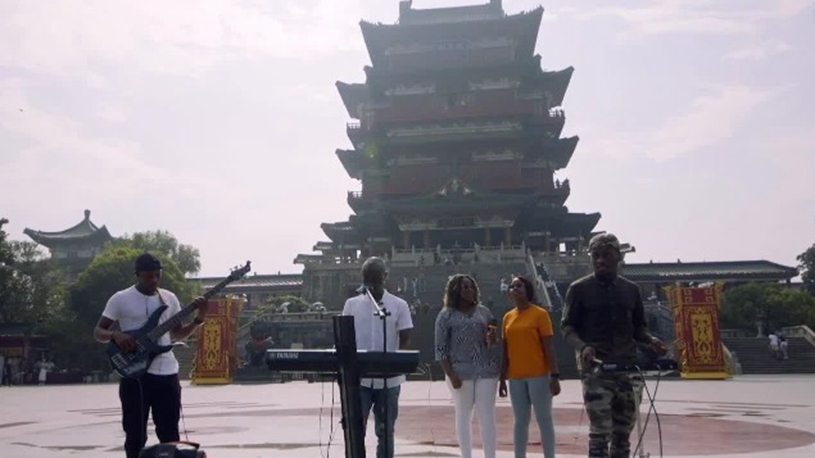
Photo taken on Aug. 8, 2022 shows the Hashima Island in Japan. (Xinhua/Zhang Xiaoyu)
The Hashima Island was a place where tens of thousands of Chinese and Korean laborers were forced and enslaved by Japan during its war of aggression, however, the history of forced labor crimes was skipped by the guidebook and tour guides there.
TOKYO, Aug. 15 (Xinhua) -- "There was no forced labor here," said a tour guide blatantly on Hashima, the fortress island near Nagasaki, where visitors are supposed to be told about the history of forced labor crimes.
In 2015, the Sites of Japan's Meiji Industrial Revolution, including the Hashima Island, were listed as a World Cultural Heritage amid huge controversy, as the island was a place where tens of thousands of Chinese and Korean laborers were forced and enslaved by Japan during its war of aggression.
In the guidebook of Hashima, there is a conspicuous omission in the long chronology of history from the Meiji period onwards, with only two records covering the 30-year period from 1925 to 1955 -- The island's coal production peaked at 411,100 tons in 1941, and that the island was torpedoed by U.S. forces in 1945.
It did not talk about the laborers who were forced to work here during the Japanese invasion period or the death toll of the laborers, not to mention "North Korea" or "China" in the guidebook.
Historical records showed that the Japanese conglomerate Mitsubishi used a great number of Korean laborers to start mining on Hashima in 1939. Starting from 1943, Mitsubishi forced Chinese war prisoners captured by the Japanese army to be enslaved there, where hundreds of Chinese and Korean laborers were killed.
The history skipped by the guidebook was obviously not touched upon by the ship's guide either. The tour guide told visitors that the coal and ore dug out of the island not only provided rich minerals for Mitsubishi shipyards and steel mills but also contributed greatly to the modernization of Japan as a whole.

Photo taken on Aug. 8, 2022 shows the Hashima Island in Japan. (Xinhua/Zhang Xiaoyu)
As the ship approaches, the island, also known as Battleship Island due to its appearance, was like a black iron beast on the sparkling sea, where buildings seemed like turrets on the deck of a battleship.
While the guide flaunted the facilities which in his eyes bolstered the beginning of modern Japanese architectural history, there was not a shred of sympathy for the dead laborers, let alone condemnation of the enslavers.
When questioned if he tells the tourists about this history at all, the guide responded by "Sorry, I don't know this history," and "I share what the company told us to."
In fact, telling the full history of forced labor at the Hashima Coal Mine on the island was a commitment pledged by Japan to UNESCO when it applied for a World Heritage Site. However, after the successful application, Japan's Industrial Heritage Information Center displayed testimonies and materials that deny the fact that Japan had workers brought there forcibly, which aroused deep disappointment and strong protest in the international community.
In 2018, the UNESCO World Heritage Committee decided to require Japan to fully inform the history of forced labor when publicizing the application of the Meiji Industrial Revolution sites. Japan remained unmoved.
In July 2021, a resolution by the World Heritage Committee "deeply regrets" that Japan failed to fully inform about the history of forced recruitment of Korean laborers and others when promoting the sites of the Meiji Industrial Revolution, such as Hashima Island, or the Battleship Island, and pointed out that the Japanese government failed to honor its commitment to the international community during the application process.
The resolution also called on the Japanese government to consider measures to disclose that many of the workers were forcibly brought to the coal mine from the Korean Peninsula and made to work under harsh conditions, and to submit a report by Dec. 1, 2022, to explain what it intends to do.
As the sea trip around Hashima Island came to a stop, someone yelled "There is no history of forced labor here!" This voice was not from the tour guide, but seemingly from some Japanese visitors on the cruise.■












